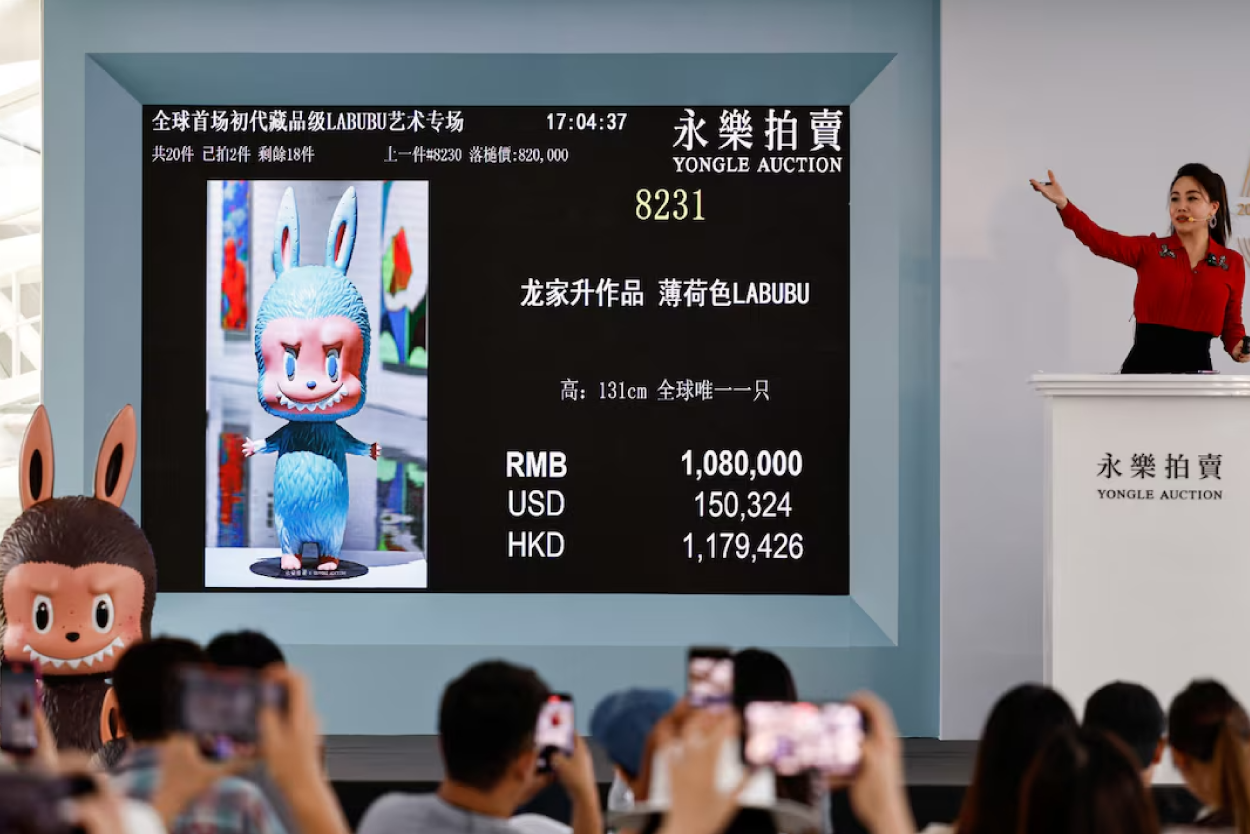4 min read
A SEPTEMBER TO REMEMBER
A September to Remember? Rates, Labor, and Market Domino Effects Setting the Stage As markets came back from the long Labor Day weekend, labor...

At what point does price decouple from purpose, and why do we keep playing along?
In recent months, a peculiar phenomenon has unfolded at the edge of global consumer culture: Labubu figurines, vinyl toys no larger than an adult human hand, began selling for thousands of dollars. One auctioned for over $10,000 (a special mega-sized mint-green collectible went for over $150k). These are not museum pieces. They are not AI-powered, gold-inlaid, or rare antiques. They are mass-produced toys. Cute, yes, but not functional, not necessary, and not obviously valuable.
And yet, that is precisely why they matter.
Labubu isn’t just a collectible. It’s a mirror. One that reflects how capital behaves in an economy that’s increasingly gamified, where scarcity, narrative, and hype increasingly replace utility, fundamentals, and time-tested valuation logic. In many ways, Labubu has more in common with Dogecoin than with, say, Disney merchandise. It’s not about the thing itself, but about what the thing signals, how it performs in the market, and how much someone else is willing to pay tomorrow. It’s speculation disguised as discovery, where timing and cultural capital replace thesis.
The implications for investors, especially institutional stewards of mission-driven capital, are not trivial.
Labubu Is a Signal, Not a Toy
The Labubu phenomenon is not irrational. It is hyper-rational: an entirely expected feature of an economic system optimized to monetize attention, financialize identity, and convert community behavior into tradable flows. In that sense, as we’ve explored in past commentaries, Labubu is not unlike:
Nor is it without historical precedent. From Tulipmania in the 1600s to the Beanie Baby bubble of the 1990s, speculative manias have long captivated markets. But what distinguishes the Labubu era is its relative self-awareness: these are not naïve bubbles but deliberately manufactured cycles, often propagated by a generation fluent in financial history and eager to replicate, exploit, and monetize the psychology behind past crazes.
What unites them all is a core structure: engineered scarcity, viral narrative loops, and reflexive price dynamics untethered from underlying value. These assets are not necessarily “bad” (though the ethics are increasingly debatable), but they are no longer investments in the traditional sense. They are speculative artifacts, economic game pieces, designed to function as Rorschach tests for a system where belief, velocity, and timing have replaced fundamentals.
It's not investing. It’s gambling packaged in collectible form. And it's part of a broader ‘gamblification’ of everything: retail platforms like Temu that mimic roulette mechanics, mystery box marketplaces (including Labubu) that reward randomness over value, and an always-on digital environment where volatility is entertainment. This dynamic mirrors, and potentially feeds into, the explosive global rise in online gambling, with this market projected to reach approximately $117.5 billion in 2025, a surge driven by mobile adoption, regulatory shifts, and widespread consumer normalization of speculative gaming.
For long-term institutions, the philosophical question is urgent: Are we investing in assets, participating in “vibes” investing, or just rolling the dice?
The Magnificent Mirror: From Labubu to the S&P 500
If Labubu illustrates how scarcity-driven speculation operates on the cultural edge, the rise of the “Magnificent Seven” mega-cap tech stocks reveals how similar dynamics now dominate the financial core.
As of mid‑2025, Apple, Microsoft, Alphabet, Amazon, Nvidia, Meta, and Tesla collectively account for approximately 34% of the S&P 500’s total market capitalization; this level of concentration reflects both their economic dominance and the market’s growing reliance on a handful of narrative-driven growth engines.
These are not speculative toys, they are some of the most profitable companies in history. Yet their market behavior increasingly mirrors Labubu-like structures:
This dynamic puts pressure on institutional discipline. Valuation multiples stretch. Risk is tolerated if it buys market exposure. Fundamentals are often subordinated to crowd psychology, not unlike the behaviors fueling collectibles, memes, or crypto.
For mission-driven investors, the concern isn’t whether these are “good” companies. Many are.
The concern is how easily narrative can override structure and how quickly structural exposure becomes performative.
What Mission-Driven Capital Must Remember
Endowments and foundations are not speculators. They are stewards.
They exist to fund breakthroughs not yet imagined, students not yet born, and missions not yet fulfilled. This is capital with purpose, not just capital with return expectations. Such a reality comes with structural advantages but also unique constraints:
But structural discipline is not automatic. It must be codified.
Codifying Clarity
Scarcity Is Not Value, Attention Is Not Alignment
Labubu is scarce. So are many assets investors chase daily. But scarcity without purpose is a branding tactic, not a reason to allocate. Endowments and foundations are not cultural trend-chasers. They are legacy-builders, and legacy is defined by what your capital enables over decades—not relative or quarterly performance.
Labubu is not a threat, and it’s essentially harmless fun, but it is a useful metaphor: for how easily meaning can be monetized, how quickly capital can drift from purpose, and for how much harder it’s becoming to hold the line. But that doesn’t mean it shouldn’t be held. Because in a system optimized for noise and a world obsessed with signal, meaning is the ultimate contrarian asset for impactful long-term performance.

4 min read
A September to Remember? Rates, Labor, and Market Domino Effects Setting the Stage As markets came back from the long Labor Day weekend, labor...

20 min read
“History doesn’t repeat itself, but it often rhymes.”

3 min read
Foundations and Fault Lines